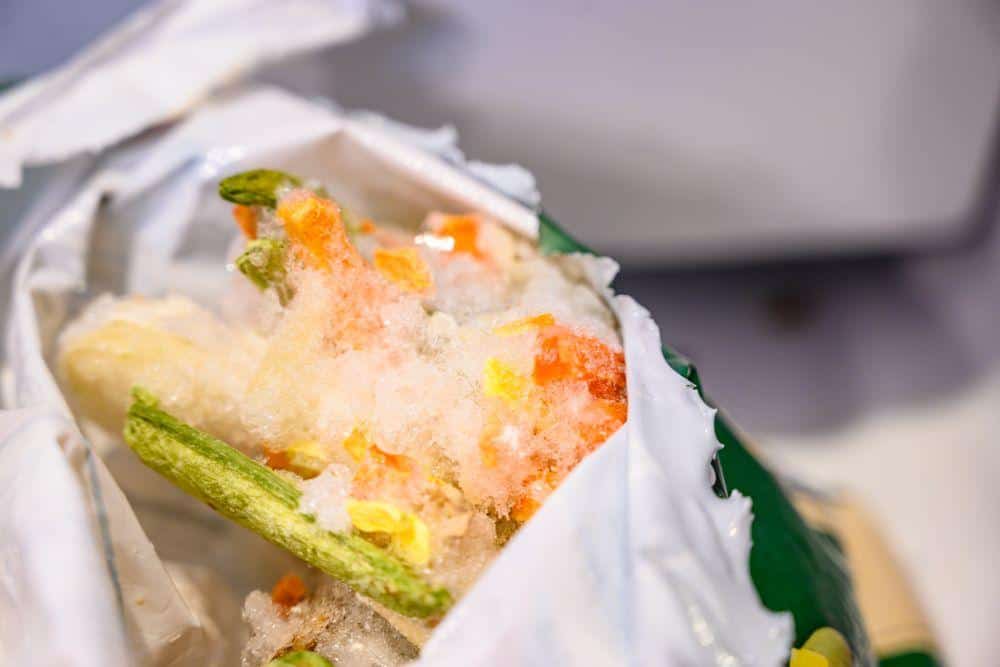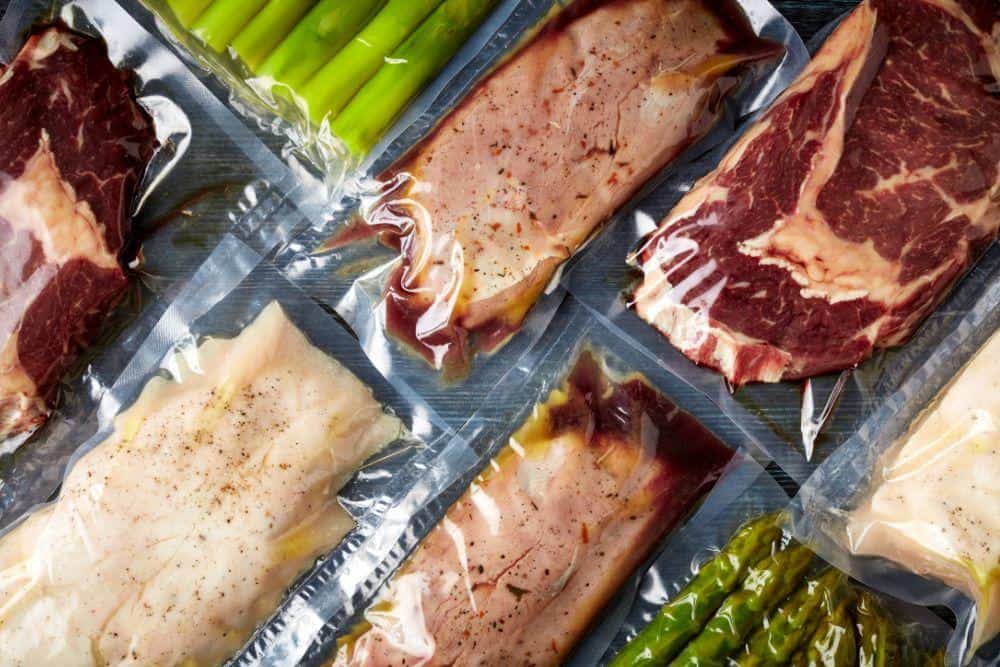Freezer burn occurs when inadequately wrapped food loses moisture due to exposure to cold, dry air in the freezer. This process leads to a few noticeable changes in your food, such as the formation of ice crystals.
The process of dehydration that occurs to inadquately packaged food in a freezer is called sublimation. It is a unique process where ice (frozen water) skips the water phase and transforms directly into a gas. This gas can then reform into small ice particles that may appear on the surface of the freezer burned food. This sublimation process has a significant negative impact on the food - including color, taste and texture.
Want to avoid freezer burn? Don't give enough space for air to come into contact with your food. Preventing a gap between your food and your storage container or wrapping is key.
Wrap your food tightly in packaging and then place in a container that is leak proof and properly sealed. An even better solution is to vacuum seal your food to completely remove the air surrounding the food. If there is no air around your food, the moisture won't be able to escape your food and cause freezer burn.
When food experiences freezer burn, you'll notice changes in its appearance. Freezer burned meat may be characterized by dark or white dry areas. Fruits and vegetables may appear shriveled when freezer burned. And most of us have seen significant ice crystals on ice cream - which is a sure sign of freezer burn. These changes occur due to moisture loss from the food, which affects its texture. For example, meats become tough and vegetables turn limp.
Freezer burn can absolutely ruin your food's flavor and texture. Most of us have been victims of consuming freezer burned food. It has a taste that is signficantly unpleasant. You can detect that distinct freezer burned food the moment you take your first bite.
Freezer burn can be even more pronounced with raw food like vegetables.
Surprisingly, freezer burn doesn't cause massive nutrient loss, but it can lead to deficiencies in essential vitamins and minerals if the food has lost significant amounts of nutrients. It’s important to note that the nutrient loss typically stays in thin layers on the surface of the food and doesn't permeate through the whole item.

Heavily Freezer Burned Food Generallly Isn’t Worth Consuming
Freezer burn itself doesn't make food unsafe to eat. Properly packaged meats can last for six months or more in the freezer. That said, food can’t stay in the freezer indefinitely. You’ll want to make sure you’re rotating food out of the freezer before it succumbs to freezer burn.
However, it’s crucial to be aware that freezing doesn't destroy bacteria, mold, or yeast; it only inactivates them. Once the food thaws, these microorganisms can become active again. Therefore, while freezer burn isn't harmful, it’s important to follow proper food safety guidelines when thawing your food to prevent any potential health risks.
To prevent freezer burn, follow these simple steps:
This was the best video I could find
Use a high-quality, airtight container, a vacuum sealer, or a combination of plastic wrap, foil, and freezer bags.
Take your food and wrap it in layers of plastic wrap or reusable freezer paper, then wrap it in a foil. Finally, place the wrapped food in a freezer bag, removing as much air as possible before sealing it. Wrapping your food in all this packaging will help protect the food, but it also makes it difficult to identify. Use markers and stickers or tape to label the wrapped food with the date and contents of the package.
Proper food storage is essential to preventing freezer burn. Organize your freezer, placing items with similar expiration dates together. Avoid storing foods near the freezer door, as that area experiences frequent temperature fluctuations. For ice cream containers, place a layer of plastic wrap over the top before putting the lid back on to minimize air exposure and reduce freezer burn.

Vacuum Seal Meats and Vegetables Prior to Freezing to Prevent Freezer burn
Maintain the right temperature in your freezer by setting it to 0°F (-18°C) or lower, as advised by the FDA. This ensures quick freezing and minimizes ice crystal formation. When freezing, arrange the food items in a single layer to ensure even freezing and easier retrieval.
Different types of food are affected by freezer burn in various ways:
To keep these items in better condition, store them in airtight packaging. For larger cuts like steaks and roasts, consider using freezer paper for an extra layer of protection.
Before storing, wash, dry, and cut your produce into pieces. Place the chopped fruits and veggies in airtight containers or use vacuum-sealed bags to prevent moisture loss.
Cover the surface of ice cream containers with plastic wrap before sealing to minimize freezer burn. This approach also works for other frozen foods like sorbets and gelatos.
Cool your baked creations before freezing them, then wrap them in plastic wrap or aluminum foil. Place them in airtight containers or freezer bags, and label them with the date for easy reference.
When defrosting food, do it right to avoid ice burn and maintain the taste. The best method is to thaw the food in the refrigerator, as it maintains a safe temperature. Avoid refreezing your food, as it can lead to dehydration and freezer burn.
If you need to defrost your food quickly, use the microwave and set it on the defrost setting. For added flavor, consider brining your food by soaking it in a saltwater solution, which helps retain moisture.
According to a registered dietitian nutritionist, freezer burn doesn't make food unsafe. However, it may affect the quality and taste. To maintain freshness and minimize the risk of foodborne illnesses, keep the freezer temperature between 0°F and -20°F. Store food in airtight containers, wrap it tightly in plastic wrap or aluminum foil, and remove as much air as possible. Plunge blanched foods into ice water before freezing to lock in nutrients and color. Rotate items in the freezer regularly and use the first-in, first-out method.
No. Both are a result of tissues freezing and the sublimation of water (when H20 transitions directly from ice to a gas without becoming liquid first. Frostbite is different in that it involves moisture within the skin freezing and damaging skin tissue.
No, freezer burn doesn't usually pose a health risk. While it may affect the taste and texture, it is generally safe to consume.
Yes, it's safe to eat food with ice crystals. The presence of ice crystals indicates freezer burn, which compromises the quality but not the safety of the food.
Freezing and freezer burn don’t promote bacterial growth. Freezing food deactivates bacteria. Even freezer burned food merely has deactivated (not dead) bacteria. When you thaw frozen or freezer burned food, deactivated bacteria can start multiplying. The effects of freezer burn are related to reducing the taste and quality of food - not bacterial growth.
